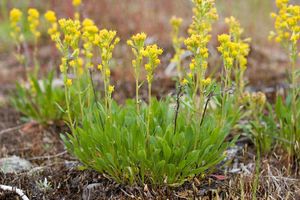Difference between revisions of "Solidago simplex"
(Tag: VisualEditor) |
m (→Taxonomy) (Tag: VisualEditor) |
||
| Line 17: | Line 17: | ||
| ordo = Asterales | | ordo = Asterales | ||
| familia = Asteraceae | | familia = Asteraceae | ||
| − | | genus = '''''Solidago'''''L | + | | genus = '''''Solidago'''' 'L |
| species = '''''Solidago simplex''''' Kuth | | species = '''''Solidago simplex''''' Kuth | ||
| subspecies = | | subspecies = | ||
| Line 23: | Line 23: | ||
==Description== | ==Description== | ||
| + | Glabrous perennial herb. Inflorescences spiciform to subracemiform, heads often with long peduncles, phyllaries imbricate, ray flowers often 8, disk flowers often 13. Basal leaves narrowly spatulate to nearly orbiculate, cauline leaves reduced upwards and not very many. <ref name=":0">Hitchcock, C. L., Cronquist, A., Giblin, D., & Legler, | ||
| + | B. et al. (2018). ''Flora of the Pacific Northwest: an illustrated manual''. | ||
| + | Seattle: University of Washington Press.</ref><ref>WTU Herbarium, Burke Museum, | ||
| + | & University of Washington. Retrieved from <nowiki>https://biology.burke.washington.edu/herbarium/imagecollection/taxon.php?Taxon=Solidago%20simplex</nowiki></ref> | ||
| + | |||
Compared to ''Solidago missourensis'' and ''S. canadensis,''the | Compared to ''Solidago missourensis'' and ''S. canadensis,''the | ||
leaves are almost entirely basal and wider, and plant is generally shorter. | leaves are almost entirely basal and wider, and plant is generally shorter. | ||
| Line 30: | Line 35: | ||
==Distribution== | ==Distribution== | ||
| + | Cascades from northern Washington to Central Oregon, Puget Trough, Rocky Mountains south to Arizona, and New Mexico, Great Lakes.<ref name=":0" /> | ||
| + | |||
==Habitat== | ==Habitat== | ||
| + | Grasslands, prairies, open forest, shorelines, lowland to alpine. | ||
| + | |||
==Uses== | ==Uses== | ||
| Line 36: | Line 45: | ||
Reference to Nlaka'pamux people using the decoction of ''S. simplex'' as a tonic to restore appetite, and a poultice of the powdered leaves as a compress for mumps.<ref>Native American Ethnobotany Database. Retrieved from <nowiki>http://naeb.brit.org/uses/search/?string=solidago+simplex</nowiki></ref> | Reference to Nlaka'pamux people using the decoction of ''S. simplex'' as a tonic to restore appetite, and a poultice of the powdered leaves as a compress for mumps.<ref>Native American Ethnobotany Database. Retrieved from <nowiki>http://naeb.brit.org/uses/search/?string=solidago+simplex</nowiki></ref> | ||
| − | == | + | ==== Ecology and Wildlife ==== |
| + | ''Solidago'' species provide important nectar and pollen sources for bees in late summer. | ||
| + | |||
==Photo Gallery== | ==Photo Gallery== | ||
<gallery> | <gallery> | ||
| Line 45: | Line 56: | ||
==References== | ==References== | ||
| + | <references /> | ||
Revision as of 22:09, 21 April 2020
- Scientific Name: Solidago simplex
- Family: Asteraceae
- Common Name: sticky goldenrod, Mt. Albert goldenrod
- Synonyms and misapplications: S. bellidifolia, S. spathulata, S. glutinosa
- Codon: SOLSIM
Contents
Taxonomy
| Trillium albidum ssp. parviflorum | |
|---|---|
| Scientific classification | |
| Kingdom: | Plantae |
| Subkingdom: | Tracheobionta |
| Phylum: | Spermatophyta |
| Subphylum: | Magnoliophyta |
| Class: | Magnoliopsida |
| Subclass: | Asteranae |
| Order: | Asterales |
| Family: | Asteraceae |
| Genus: | Solidago' 'L |
| Species: | Solidago simplex Kuth |
Description
Glabrous perennial herb. Inflorescences spiciform to subracemiform, heads often with long peduncles, phyllaries imbricate, ray flowers often 8, disk flowers often 13. Basal leaves narrowly spatulate to nearly orbiculate, cauline leaves reduced upwards and not very many. [1][2]
Compared to Solidago missourensis and S. canadensis,the leaves are almost entirely basal and wider, and plant is generally shorter.
Bloom Period
June- September
Distribution
Cascades from northern Washington to Central Oregon, Puget Trough, Rocky Mountains south to Arizona, and New Mexico, Great Lakes.[1]
Habitat
Grasslands, prairies, open forest, shorelines, lowland to alpine.
Uses
First Nations
Reference to Nlaka'pamux people using the decoction of S. simplex as a tonic to restore appetite, and a poultice of the powdered leaves as a compress for mumps.[3]
Ecology and Wildlife
Solidago species provide important nectar and pollen sources for bees in late summer.
Photo Gallery
References
- ↑ 1.0 1.1 Hitchcock, C. L., Cronquist, A., Giblin, D., & Legler, B. et al. (2018). Flora of the Pacific Northwest: an illustrated manual. Seattle: University of Washington Press.
- ↑ WTU Herbarium, Burke Museum, & University of Washington. Retrieved from https://biology.burke.washington.edu/herbarium/imagecollection/taxon.php?Taxon=Solidago%20simplex
- ↑ Native American Ethnobotany Database. Retrieved from http://naeb.brit.org/uses/search/?string=solidago+simplex



